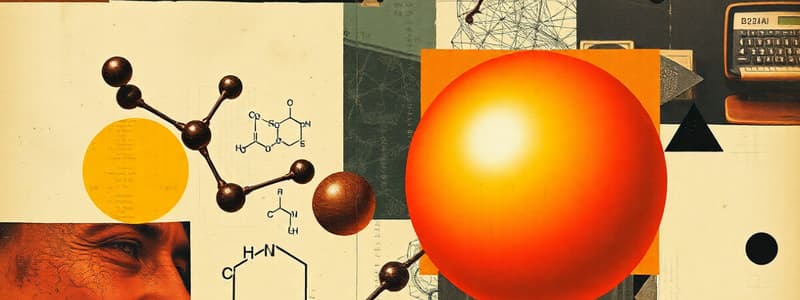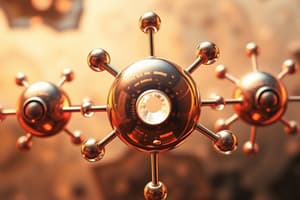Podcast
Questions and Answers
A compound is found to be insoluble in water, but soluble in benzene. It also has a low melting point. Which type of compound is it MOST likely to be?
A compound is found to be insoluble in water, but soluble in benzene. It also has a low melting point. Which type of compound is it MOST likely to be?
- Ionic
- Nonpolar molecular (correct)
- Metallic
- Polar molecular
Which of the following characteristics is LEAST indicative of an ionic compound?
Which of the following characteristics is LEAST indicative of an ionic compound?
- Electrical conductivity when melted
- High melting point
- Low boiling point (correct)
- Solubility in water
When nonmetals share electrons equally, the resulting compound is classified as?
When nonmetals share electrons equally, the resulting compound is classified as?
- Metallic
- Polar molecular
- Nonpolar molecular (correct)
- Ionic
Element X is in the same period as element Y, but is located several groups to the left of element Y. Which statement regarding their electronegativity is MOST likely true?
Element X is in the same period as element Y, but is located several groups to the left of element Y. Which statement regarding their electronegativity is MOST likely true?
Which element has the LOWEST ionization energy?
Which element has the LOWEST ionization energy?
Arrange the following elements in order of INCREASING atomic radius: Cl, S, P, Si.
Arrange the following elements in order of INCREASING atomic radius: Cl, S, P, Si.
Which statement accurately compares the ionic radius of a cation to its neutral atom?
Which statement accurately compares the ionic radius of a cation to its neutral atom?
Moving down a group of metals, reactivity generally increases. Which factor contributes MOST to this trend?
Moving down a group of metals, reactivity generally increases. Which factor contributes MOST to this trend?
Element A and Element B are in the same group, but Element A is located higher in the group than Element B. Which of the following statements is MOST likely true regarding their reactivity as nonmetals?
Element A and Element B are in the same group, but Element A is located higher in the group than Element B. Which of the following statements is MOST likely true regarding their reactivity as nonmetals?
Which of the following BEST describes the effect of inner electrons on the attraction between the nucleus and valence electrons?
Which of the following BEST describes the effect of inner electrons on the attraction between the nucleus and valence electrons?
How does the effective nuclear charge (ENC) change as you move across a period from left to right, and why?
How does the effective nuclear charge (ENC) change as you move across a period from left to right, and why?
In a lab setting, you observe that potassium (K) reacts more vigorously with water than sodium (Na). What explains this difference in reactivity?
In a lab setting, you observe that potassium (K) reacts more vigorously with water than sodium (Na). What explains this difference in reactivity?
Why are transition metals generally LESS reactive than alkali metals or alkaline earth metals?
Why are transition metals generally LESS reactive than alkali metals or alkaline earth metals?
Consider the elements oxygen (O) and fluorine (F). Which statement is FALSE?
Consider the elements oxygen (O) and fluorine (F). Which statement is FALSE?
Consider the elements lithium (Li) and sodium (Na). Which statement is TRUE?
Consider the elements lithium (Li) and sodium (Na). Which statement is TRUE?
Which of the following statements correctly compares the properties of sodium (Na) and magnesium (Mg)?
Which of the following statements correctly compares the properties of sodium (Na) and magnesium (Mg)?
Which of the following compounds would you predict to have the HIGHEST lattice energy?
Which of the following compounds would you predict to have the HIGHEST lattice energy?
Which of the following represents a polar molecule?
Which of the following represents a polar molecule?
Which of the following elements would you expect to have the GREATEST difference between its first and second ionization energies?
Which of the following elements would you expect to have the GREATEST difference between its first and second ionization energies?
Predict the products when potassium metal reacts with chlorine gas.
Predict the products when potassium metal reacts with chlorine gas.
Flashcards
Ionic Compounds
Ionic Compounds
Formed when metals transfer electrons to nonmetals, creating positive (cation) and negative (anion) ions.
Properties of Ionic Compounds
Properties of Ionic Compounds
High melting and boiling points, soluble in water (usually), conduct electricity when dissolved or melted, hard and brittle.
Molecular Compounds
Molecular Compounds
Formed when nonmetals share electrons (covalent bonding).
Polar Molecular Compounds
Polar Molecular Compounds
Signup and view all the flashcards
Nonpolar Molecular Compounds
Nonpolar Molecular Compounds
Signup and view all the flashcards
Electronegativity
Electronegativity
Signup and view all the flashcards
Electronegativity Trend
Electronegativity Trend
Signup and view all the flashcards
Ionization Energy
Ionization Energy
Signup and view all the flashcards
Ionization Energy Trend
Ionization Energy Trend
Signup and view all the flashcards
Atomic Radius
Atomic Radius
Signup and view all the flashcards
Atomic Radius Trend
Atomic Radius Trend
Signup and view all the flashcards
Shielding Effect
Shielding Effect
Signup and view all the flashcards
Effective Nuclear Charge (ENC)
Effective Nuclear Charge (ENC)
Signup and view all the flashcards
Alkali Metals (Group 1)
Alkali Metals (Group 1)
Signup and view all the flashcards
Metal Reactivity
Metal Reactivity
Signup and view all the flashcards
Reactivity Trend (Metals)
Reactivity Trend (Metals)
Signup and view all the flashcards
Reactivity Trend (Nonmetals)
Reactivity Trend (Nonmetals)
Signup and view all the flashcards
Cations
Cations
Signup and view all the flashcards
Anions
Anions
Signup and view all the flashcards
Study Notes
- Ionic compounds involve electron transfer from metals to nonmetals, creating cations (positive ions) and anions (negative ions).
Properties of Ionic Compounds
- High melting and boiling points are characteristic.
- Usually soluble in water.
- Conduct electricity when dissolved or melted.
- Hard and brittle crystalline solids due to strong electrostatic forces.
Molecular Compounds
- Formed by nonmetals sharing electrons through covalent bonding.
Polar Molecular Compounds
- Unequal sharing of electrons results in partial positive and negative sides (dipoles).
- Usually soluble in water.
- Do not conduct electricity.
- Exhibit medium melting/boiling points.
Nonpolar Molecular Compounds
- Equal sharing of electrons means no charge separation (no dipoles).
- Insoluble in water but soluble in nonpolar solvents like oil or benzene.
- Low melting/boiling points.
Identifying Mystery Compounds
- Conductivity in water: High conductivity indicates an ionic compound.
- Solubility in water: Soluble suggests ionic or polar; insoluble suggests nonpolar.
- Melting/boiling points: High for ionic, medium for polar, low for nonpolar.
- Physical state at room temperature: Solid suggests ionic, liquid/gas suggests molecular.
Periodic Trends: Electronegativity
- Definition: An atom's ability to attract electrons.
- Trend: Increases across a period, decreases down a group.
- Reason: More protons increase attraction; added energy levels (shielding) weaken it.
- Highest: Fluorine (F).
- Lowest: Cesium (Cs).
Periodic Trends: Ionization Energy
- Definition: The energy needed to remove an electron.
- Trend: Increases across a period, decreases down a group.
- Reason: Across a period, more protons hold electrons tighter; down a group, more shielding makes removal easier.
Periodic Trends: Atomic Radius
- Definition: The size of an atom.
- Trend: Decreases across a period, increases down a group.
- Reason: Across a period, more protons pull electrons in tighter; down a group, more energy levels increase size.
Periodic Trends: Ionic Radius
- Cations (positive ions) are smaller than their atoms due to lost electrons reducing repulsion.
- Anions (negative ions) are larger than their atoms due to gained electrons increasing repulsion.
Periodic Trends: Reactivity of Metals
- Increases down a group (larger atoms lose electrons easily).
- Decreases across a period (more protons make it harder to lose electrons).
Periodic Trends: Reactivity of Nonmetals
- Increases across a period and up a group.
- Fluorine is the most reactive nonmetal.
Shielding Effect
- Inner electrons block the nucleus's pull on outer electrons.
- Trend: Increases down a group due to more inner electrons.
- Stays constant across a period.
Effective Nuclear Charge (ENC)
- Net positive charge felt by valence electrons.
- Trend: Increases across a period due to more protons with the same shielding.
- Decreases down a group as more shielding reduces attraction.
Reactivity of Metals
- Metals react by losing electrons.
- Alkali Metals (Group 1) are the most reactive; reactivity increases down the group.
- Alkaline Earth Metals (Group 2) are also reactive, but less so than Group 1.
- Transition Metals are less reactive due to a stronger nuclear charge.
Studying That Suits You
Use AI to generate personalized quizzes and flashcards to suit your learning preferences.




